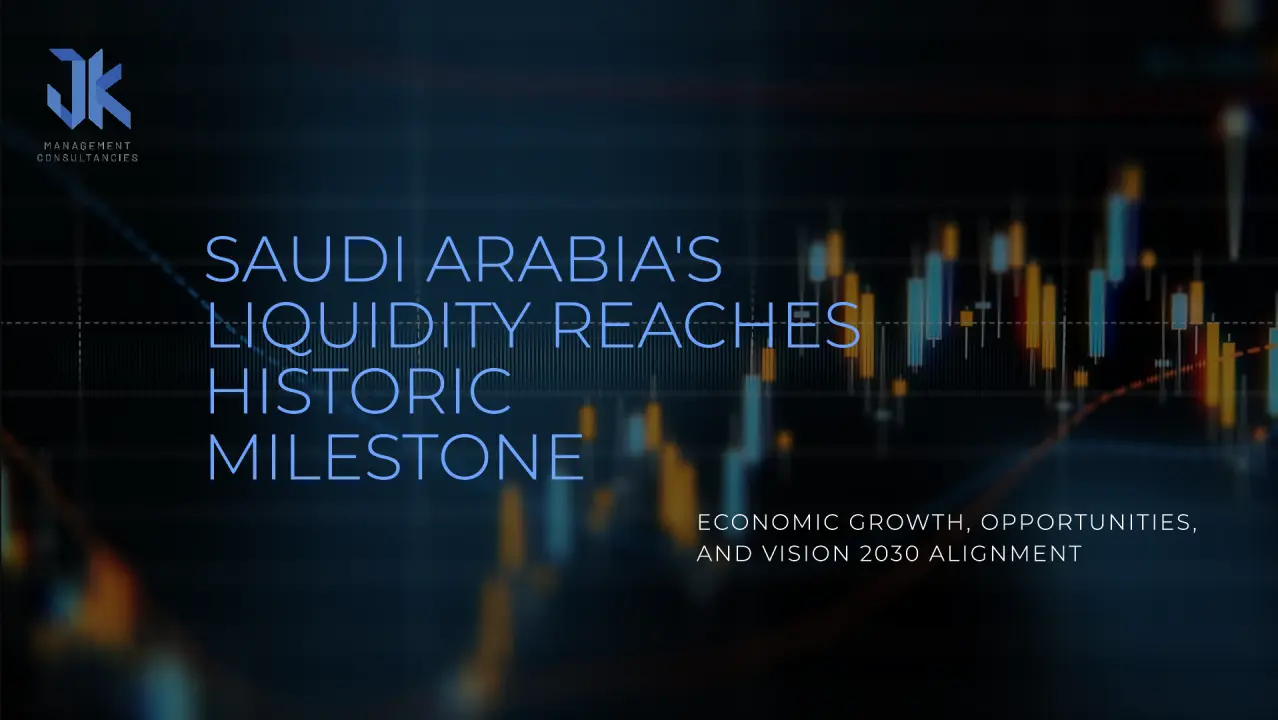Saudi Arabia’s financial landscape continues to experience rapid growth, with liquidity reaching an unprecedented SAR 2.898 trillion ($772.3 billion) by the end of Q2 2024, marking a historic milestone in the country’s economic journey. This substantial increase in liquidity is a powerful indicator of the Kingdom’s ongoing efforts to position itself as a global economic powerhouse and align with the ambitious goals of Vision 2030. The liquidity surge not only reflects the strength of the Saudi economy but also offers a glimpse into the vast opportunities that lie ahead for investors, businesses, and stakeholders.
Overview of Liquidity Growth
According to the Saudi Central Bank’s July 2024 Statistical Bulletin, liquidity in the Saudi market, measured by the broad money supply (M3), grew by an impressive 9% annually. This reflects an increase of SAR 238.15 billion ($63.5 billion) compared to the same period in 2023 when liquidity was recorded at SAR 2.660 trillion ($709.2 billion). The growth between Q1 and Q2 of 2024 was equally significant, with a quarter-on-quarter rise of 3%, equating to SAR 74.96 billion ($20 billion). As of July 2024, liquidity reached SAR 2.869 trillion ($765.3 billion), showing the continuing upward trajectory of the Kingdom’s financial system.
This liquidity growth is not just a reflection of the increasing money supply but also a strong indicator of the vibrancy of Saudi Arabia’s economic framework. The government’s proactive fiscal policies, diversification strategies, and efforts to strengthen the private sector all contribute to the expansion of financial resources in the market.
Key Drivers Behind Liquidity Growth
- Vision 2030 and Economic Diversification: One of the primary drivers of liquidity growth in Saudi Arabia is the Kingdom’s Vision 2030 initiative. This comprehensive plan aims to diversify the economy away from oil dependency and foster sustainable economic development. By creating opportunities in non-oil sectors such as tourism, entertainment, renewable energy, and technology, Saudi Arabia has managed to stimulate both local and international investment, resulting in increased financial flows and liquidity.
- Government Initiatives and Public Investment Fund (PIF): The Saudi government has been instrumental in driving liquidity growth by launching key initiatives to promote economic development. The Public Investment Fund (PIF), with its vast resources, has played a pivotal role in channeling investments into strategic sectors such as infrastructure, housing, and mega-projects like NEOM and the Red Sea Project. These initiatives have contributed to higher demand deposits and overall money supply growth.
- Rising Foreign Direct Investment (FDI): In recent years, Saudi Arabia has become an attractive destination for foreign direct investment (FDI), which has significantly contributed to the growth of liquidity. The government’s efforts to create a business-friendly environment, streamline regulatory processes, and open up more sectors to foreign investment have drawn interest from global companies and investors. The SAR 1.421 trillion ($378.9 billion) in demand deposits showcases the growing confidence of both domestic and international investors in the Kingdom’s financial stability.
- Banking Sector Expansion: The Saudi banking sector continues to be a crucial pillar of the economy. With increasing participation in both domestic and international financial markets, banks in Saudi Arabia have strengthened their balance sheets, expanded their lending capabilities, and contributed to overall liquidity. The significant rise in time and savings deposits (SAR 903.7 billion, or $240.9 billion) further underscores the growth of the banking sector and its role in facilitating economic growth.
- Increased Consumption and Investment: The rise in consumer spending, coupled with increased investment activity in various sectors, has also fueled liquidity growth. As Vision 2030 initiatives take shape and new projects come online, businesses and individuals alike are contributing to the expansion of financial resources in the market.
Breakdown of the Money Supply
The broad money supply (M3), which provides the most comprehensive measure of liquidity in Saudi Arabia, is composed of several key components:
- Demand Deposits: SAR 1.421 trillion ($378.9 billion), or 49% of the total money supply, is held in demand deposits. These deposits reflect the immediate availability of funds for businesses and individuals, indicating strong liquidity in the banking system.
- Time and Savings Deposits: SAR 903.7 billion ($240.9 billion), or 31% of the total, is held in time and savings deposits. This component reflects the growing culture of saving and longer-term investments within the Kingdom.
- Quasi-Monetary Deposits: Representing 12% of the total money supply, quasi-monetary deposits stand at SAR 344.4 billion ($91.8 billion). These deposits include foreign currency deposits, deposits linked to letters of credit, and repurchase agreements (repos) with banks.
- Currency in Circulation Outside Banks: SAR 229.2 billion ($61.1 billion), or 8% of the total money supply, is in the form of currency circulating outside of banks. This figure highlights the portion of liquidity that remains outside the formal banking system but still contributes to the overall economy.
Significance of the Liquidity Surge
The growth in liquidity is a critical factor in driving economic development in Saudi Arabia. With increased financial resources circulating within the economy, businesses have access to the capital needed to expand operations, undertake new projects, and contribute to GDP growth. Additionally, higher liquidity levels support the financial system’s stability, allowing banks to offer more credit to businesses and consumers alike.
Furthermore, this surge aligns with Saudi Arabia’s broader macroeconomic goals under Vision 2030. By fostering a stable and liquid financial environment, the government is creating the conditions necessary for sustainable growth, job creation, and economic diversification. As the Kingdom continues to attract foreign investment and expand its non-oil sectors, liquidity will play a key role in driving long-term economic transformation.
Implications for Investors and Businesses
For both local and international investors, Saudi Arabia’s growing liquidity presents significant opportunities. The availability of financial resources, coupled with the government’s commitment to creating a pro-business environment, positions the Kingdom as an attractive destination for investment in various sectors, including real estate, technology, healthcare, and manufacturing.
Future Outlook
Looking ahead, Saudi Arabia is expected to maintain its upward liquidity trajectory as the economy continues to diversify and Vision 2030 projects gain momentum. The Kingdom’s focus on non-oil sectors, coupled with ongoing reforms to enhance the business environment, will likely attract more investment and drive further financial growth.
As the world’s largest oil exporter transitions toward a knowledge-based economy, liquidity will remain a key indicator of the health of the Saudi financial system. Policymakers will continue to monitor liquidity levels and ensure that the financial system remains robust and capable of supporting the country’s long-term economic goals.
How J K Management Consultancies Can Assist
At J K Management Consultancies, we understand the complexities of doing business in Saudi Arabia and the critical role liquidity plays in the country’s economic growth. As a leading consultancy firm, we offer a range of services designed to help businesses navigate the regulatory landscape, secure financing, and establish a strong presence in the Kingdom.
Whether you are a foreign investor looking to tap into the Saudi market or a local business seeking to expand, J K Management Consultancies can provide expert guidance on all aspects of business setup, including licensing, investment structuring, and compliance with local laws.
We specialize in helping businesses take advantage of the opportunities presented by Saudi Arabia’s growing liquidity and economic transformation. Our team of experienced professionals is ready to assist you in achieving your business goals in the Kingdom.
Conclusion
The record-breaking liquidity levels in Saudi Arabia are a testament to the country’s economic resilience and its commitment to achieving Vision 2030 objectives. With SAR 2.898 trillion ($772.3 billion) in liquidity, the Kingdom is well-positioned to continue its economic growth and attract investment from around the world.
As the financial landscape evolves, businesses and investors must stay informed about the latest developments and opportunities in the market. By partnering with J K Management Consultancies, you can leverage our expertise and local knowledge to succeed in Saudi Arabia’s dynamic and growing economy.
#SaudiArabiaLiquidity #EconomicGrowth #Vision2030 #SaudiEconomy #InvestmentInSaudi #BusinessOpportunities #SaudiBankingSector #M3MoneySupply #JKManagementConsultancies #ForeignInvestment #PIF #PublicInvestmentFund #BusinessInSaudi #SaudiArabiaOpportunities #FinancialStability #SaudiInvestment #EconomicMilestone #MiddleEastBusiness #GlobalInvestors #NonOilEconomy
Saudi liquidity growth, Vision 2030, Saudi economic milestone, Saudi Central Bank, money supply M3, Saudi investment opportunities, financial stability in Saudi Arabia, Saudi banking sector, Saudi demand deposits, time and savings deposits in Saudi Arabia, foreign direct investment in Saudi Arabia, PIF investments, Saudi non-oil sector growth, Saudi financial market, economic diversification, business in Saudi Arabia, JK Management Consultancies, investment company setup in Saudi Arabia, business expansion in Saudi, opportunities for foreign investors in Saudi Arabia, liquidity-driven economic growth







